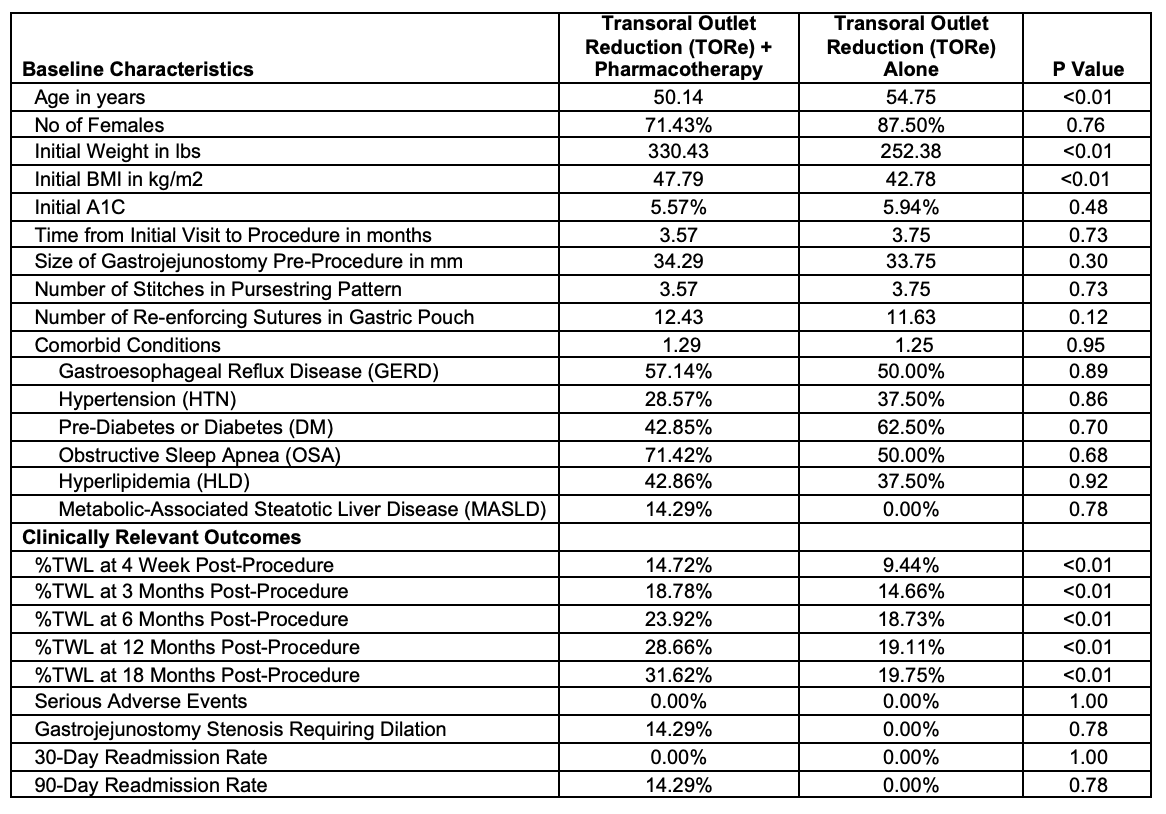Monday Poster Session
Category: Diet, Nutrition, and Obesity
P2687 - Combination Transoral Outlet Reduction (TORe) Plus Pharmacotherapy vs Transoral Outlet Reduction (TORe) Alone for Treatment of Weight Regain After Roux-en-Y Gastric Bypass
Monday, October 27, 2025
10:30 AM - 4:00 PM PDT
Location: Exhibit Hall
- TM
Thomas R. McCarty, MD, MPH
Houston Methodist Hospital
Houston, TX
Presenting Author(s)
Ronan Allencherril, MD, Thomas R. McCarty, MD, MPH
Houston Methodist Hospital, Houston, TX
Introduction: Clinically significant weight regain after Roux-en-Y gastric bypass is common, occurring in up to 50% of patients post-surgery. Currently, the efficacy of glucagon-like peptide-1 (GLP-1) and dual GLP-1/glucose-dependent insulinotropic polypeptide (GIP) receptor agonists to augment weight loss along with endoscopic gastric bypass revision remains unknown. The aim of this study was to evaluate the efficacy and safety of transoral outlet reduction (TORe) with GLP-1/GIP receptor agonists compared with TORe alone.
Methods: This was a retrospective study of patients undergoing TORe between September 2023 and November 2024. The TORE+pharmacotherapy group had semaglutide or tirzepatide initiated prior to (and continued after) TORe with outcomes compared versus patients who underwent TORe alone. All patients were evaluated by a registered dietitian and behavioral psychologist before the procedure and underwent extensive education and training in lifestyle modification. All TORe procedures were performed with a pursestring suture pattern of the gastrojejunostomy secured and tightened over a 7 mm bougie and at least one re-enforcing interrupted suture in the gastric pouch. The primary outcome was percent total body weight loss (%TWL) 12 months after TORe with and without pharmacotherapy. Secondary outcomes included improvement in obesity-associated comorbid conditions. Statistical analysis included Fisher exact test, t-test, and Wilcoxon test, accordingly.
Results: A total of 15 patients underwent TORe for the treatment of weight regain, of which 46.67% were on concomitant pharmacotherapy. Baseline characteristics from the two groups are shown in Table 1. Patients underwent lifestyle modification training an average of 3.67 months prior to TORe. During this time, patients in the pharmacotherapy group were started on medication (mean 3.57 months prior to TORe). Patients with TORe+pharmacotherapy achieved significantly greater weight loss at 3, 6, 12, and 18 months (P< 0.01). No serious adverse events occurred with no differences in rates of gastrojejunostomy stenosis or 30- and 90-day readmission. There was no difference comorbidity resolution or improvement between groups (all P >0.05).
Discussion: Addition of GLP-1 or GLP-1/GIP receptor agonists 3 months prior to TORe resulted in superior weight loss compared to TORe alone. Further studies are critical to determine optimal dose, timing, and duration of pharmacotherapy.

Figure: Table 1. Baseline Characteristics and Outcomes of Transoral Outlet Reduction (TORe) With and Without Pharmacotherapy
Disclosures:
Ronan Allencherril indicated no relevant financial relationships.
Thomas McCarty: Covidien/Medtronic – Consultant. Endoquest Robotics – Consultant.
Ronan Allencherril, MD, Thomas R. McCarty, MD, MPH. P2687 - Combination Transoral Outlet Reduction (TORe) Plus Pharmacotherapy vs Transoral Outlet Reduction (TORe) Alone for Treatment of Weight Regain After Roux-en-Y Gastric Bypass, ACG 2025 Annual Scientific Meeting Abstracts. Phoenix, AZ: American College of Gastroenterology.
Houston Methodist Hospital, Houston, TX
Introduction: Clinically significant weight regain after Roux-en-Y gastric bypass is common, occurring in up to 50% of patients post-surgery. Currently, the efficacy of glucagon-like peptide-1 (GLP-1) and dual GLP-1/glucose-dependent insulinotropic polypeptide (GIP) receptor agonists to augment weight loss along with endoscopic gastric bypass revision remains unknown. The aim of this study was to evaluate the efficacy and safety of transoral outlet reduction (TORe) with GLP-1/GIP receptor agonists compared with TORe alone.
Methods: This was a retrospective study of patients undergoing TORe between September 2023 and November 2024. The TORE+pharmacotherapy group had semaglutide or tirzepatide initiated prior to (and continued after) TORe with outcomes compared versus patients who underwent TORe alone. All patients were evaluated by a registered dietitian and behavioral psychologist before the procedure and underwent extensive education and training in lifestyle modification. All TORe procedures were performed with a pursestring suture pattern of the gastrojejunostomy secured and tightened over a 7 mm bougie and at least one re-enforcing interrupted suture in the gastric pouch. The primary outcome was percent total body weight loss (%TWL) 12 months after TORe with and without pharmacotherapy. Secondary outcomes included improvement in obesity-associated comorbid conditions. Statistical analysis included Fisher exact test, t-test, and Wilcoxon test, accordingly.
Results: A total of 15 patients underwent TORe for the treatment of weight regain, of which 46.67% were on concomitant pharmacotherapy. Baseline characteristics from the two groups are shown in Table 1. Patients underwent lifestyle modification training an average of 3.67 months prior to TORe. During this time, patients in the pharmacotherapy group were started on medication (mean 3.57 months prior to TORe). Patients with TORe+pharmacotherapy achieved significantly greater weight loss at 3, 6, 12, and 18 months (P< 0.01). No serious adverse events occurred with no differences in rates of gastrojejunostomy stenosis or 30- and 90-day readmission. There was no difference comorbidity resolution or improvement between groups (all P >0.05).
Discussion: Addition of GLP-1 or GLP-1/GIP receptor agonists 3 months prior to TORe resulted in superior weight loss compared to TORe alone. Further studies are critical to determine optimal dose, timing, and duration of pharmacotherapy.

Figure: Table 1. Baseline Characteristics and Outcomes of Transoral Outlet Reduction (TORe) With and Without Pharmacotherapy
Disclosures:
Ronan Allencherril indicated no relevant financial relationships.
Thomas McCarty: Covidien/Medtronic – Consultant. Endoquest Robotics – Consultant.
Ronan Allencherril, MD, Thomas R. McCarty, MD, MPH. P2687 - Combination Transoral Outlet Reduction (TORe) Plus Pharmacotherapy vs Transoral Outlet Reduction (TORe) Alone for Treatment of Weight Regain After Roux-en-Y Gastric Bypass, ACG 2025 Annual Scientific Meeting Abstracts. Phoenix, AZ: American College of Gastroenterology.
